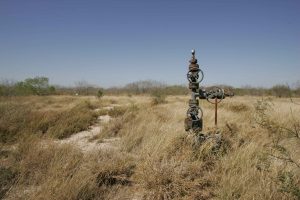By Romany Webb

Residents of Corpus Christi, a coastal town in southern Texas, are reeling this week after learning that methane has been leaking into their water supplies for at least five years. The source of the leak is two natural gas wells that were abandoned in the 1980s. Despite the fact that the leaking wells underlie the Choke Canyon Reservoir, one of Corpus Christi’s main water sources, officials say there’s no reason for concern as the methane is dispersing naturally and does not pose a fire or explosion risk. That is, however, small comfort for those concerned about climate change.
Methane is a highly potent greenhouse gas with a global warming potential 84 times that of carbon dioxide over a 20 year time horizon. It is the primary component of natural gas, the production of which has long been known to contribute to overall greenhouse gas emissions, as methane leaks from wells during drilling and completion. The reports from Corpus Christi suggest those leaks may continue long after the wells are abandoned. This is more likely to occur when a well has not been closed or “plugged,” which involves pumping cement or another substance into the wellbore to seal it at the top. The Texas Railroad Commission (“RRC”) estimates that there are currently over 1,300 unplugged wells across the state. The number is even higher here in New York, with the Department of Environmental Conservation (“DEC”) identifying 3,500 unplugged wells. In neighboring Pennsylvania, 8,200 unplugged wells have been identified. The entity responsible for those wells is often unknown, so plugging falls to state regulatory agencies. Unfortunately, their efforts are often hampered by a lack of financial resources.
The cost of well plugging varies, but can be up to $50,000. This cost is typically borne by gas operators who are responsible, under state laws, for plugging wells that are no longer used. (See, for example, 6 New York CRR § 555.1, 25 Pennsylvania Code § 78.91, and 16 Texas Code § 3.14.) However, operators may be exempt from responsibility in some situations, including where they go bankrupt. Unless a bankrupt operator’s wells are sold to a third party, who would then become responsible for plugging, the state will have to step in. To ensure they have the financial resources to do so, states collect bonds or other financial securities from operators, before they are permitted to drill a will. Often, however, those securities do not cover the full cost of plugging. For instance, New York and Pennsylvania may collect as little as $2,500 per well, equivalent to just five percent of plugging costs.
Recognizing this, some policy-makers have called for an increase in the amount of financial securities, to better reflect plugging costs. That is certainly important to ensure sufficient funding is available to plug wells that are abandoned in the future. But what about the thousands of wells that have already been abandoned and left unplugged? Many of those wells were drilled before states began collecting securities from operators. The states often do not even know who the operators were. In Pennsylvania, for example, there are no operator records for wells drilled between 1859 and 1955. This is because, prior to 1955, state law did not require operators to report when and where drilling occurred. (Interestingly, some commentators have suggested that, due to the lack of reporting, the Pennsylvania Department of Environmental Protection may not be aware of all unplugged wells. One recent article indicated that up to 200,000 such wells may be unaccounted for.)
Some states have attempted to fund the plugging of old wells through fees collected from operators applying to drill new ones. In New York, for example, the DEC levies a $100 fee on each drilling permit application. The fees are paid into the DEC’s Oil and Gas Account, which is used to fund its well plugging activities. However, according to the DEC, because of recent declines in “permitting activity . . . the Oil & Gas Account has been dramatically reduced, effectively precluding the [DEC’s] ability to plug” wells. This problem was temporarily addressed through the FY2013-14 state budget, which included $2 million for the plugging of abandoned wells. While some progress was made (as documented here), there remains a significant backlog of unplugged wells. Should taxpayers be expected to continue footing the bill?
A different, and arguably fairer approach, has been taken in Texas. Initially, the Texas RRC sought to fund well plugging through a $100 drilling permit fee, just as the DEC does. However, the RRC quickly realized, as the DEC now has, that in times of reduced drilling such fees would not be sufficient to fund well plugging. The RRC, therefore, worked with the Texas legislature to secure additional funding. Drilling permit fees were increased to $200-300 (depending on the length of the well) and a new fee levied on production. That fee is set at 1/15 of a cent per thousand cubic feet of gas and 5/8 of a cent per barrel of oil, which may not sound like much but, with over seven trillion cubic feet of gas and 1.2 billion barrels of oil produced annually in Texas, can generate over $12 million for the RRC. This, together with other fees, has allowed the RRC to accelerate well plugging. Prior to the fee changes, an average of just over 400 wells were plugged annually, compared to over 1,300 after the changes. While this week’s report from Corpus Christi shows that the RRC still has more work to do, regulators in other states would be well advised to follow its lead, and increase the plugging fees collected from industry. Without such increases, the number of unplugged wells in New York, Pennsylvania, and elsewhere will likely continue to rise, as will methane emissions.


